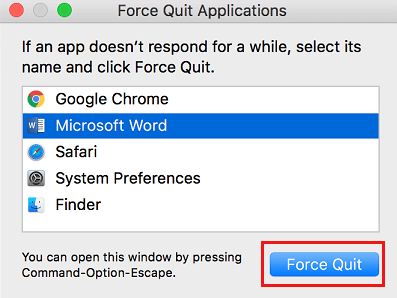

- #Mac quit all network processes password#
- #Mac quit all network processes free#
- #Mac quit all network processes mac#
At the top of the windowĪt the top of the Activity Monitor window, you will find a few buttons, tabs and a search bar.

To open Activity Monitor, you can press Command – Space Bar, then type “activity monitor” and hit enter. When you view the processes, you also get information about how much memory and CPU those processes are using. In Activity Monitor, you can view the processes (programs) that are currently running on your Mac. In this article, we will go over some Activity Monitor basics, describe some common processes you are likely to find and tell how you can find out more about a particular process on your Mac. But, if you have looked at Activity Monitor, and you are like most people, you don’t have a clue what most of the processes you find there actually do or if they should even be there running on your computer.

#Mac quit all network processes free#
Sometimes the fix is as simple as closing a web page to free up resources for your other processes. It comes in handy when you find your Mac’s fan is running loudly and your computer has slowed down. In Activity Monitor, you can check which processes are using your Mac’s resources and, if necessary, kill (stop) the process.

#Mac quit all network processes mac#
This immediately terminates the Internet Explorer process on the user's machine, and should result in them regaining control of their system.Many Mac users know about Activity Monitor. Now all we need to do is tell the user's machine to terminate that process. This tells us that Internet Explorer has the process ID number 8735 associated with it. Root 8745 0.0 0.1 28548 1496 ? S 1:23PM 0:00.16 /Library/Application Support/Norton Solutions Support/Norton AntiVirus/DiskMountNotify.app/Contents/MacOS/DiskMountNotĪdmin 8746 0.0 0.1 98788 1300 ? S 1:23PM 0:00.12 /Library/Application Support/Norton Solutions Support/Norton AntiVirus/ScanNotification.app/Contents/MacOS/ScanNotificĪdmin 8747 0.0 0.1 98676 1216 ? S 1:23PM 0:00.15 /Library/Application Support/Norton Solutions Support/Scheduler/SymSecondaryLaunch.app/Contents/MacOS/SymSecondaryLaun User 8735 0.0 1.2 179316 18452 ? S 1:23PM 0:09.86 /Applications/Internet Explorer.app/Contents/MacOS/Internet Explorer /Applications/Internet Explorer.app/Contents/MacOĪdmin 8736 0.0 0.2 150340 2736 ? S 1:23PM 0:00.26 /Applications/Timbuktu Pro/Timbuktu Pro.app/Contents/SharedSupport/Timbuktu Host Menu.app/Contents/MacOS/Timbuktu HostĪdmin 8744 0.0 0.2 151164 3040 ? S 1:23PM 0:00.35 /Library/Application Support/Norton Solutions Support/SymQuickMenu/SymQuickMenu.app/Contents/MacOS/SymQuickMenu -psn_0 USER PID %CPU %MEM VSZ RSS TT STAT STARTED TIME COMMAND This results in the Macintosh displaying a list of running processes that resembles the following: Now we need to find Internet Explorer in their process list. We connect to their computer via SSH and get to the command line. We'd like to terminate Internet Explorer for them so that they can save the data in their other programs and reboot the Mac (just to be safe). Let's assume that a user has called us to tell us that Internet Explorer seems to be locked up on their Macintosh. When the next command prompt appears, you are connected to the remote computer and are issuing commands that are running on THAT computer, not yours.
#Mac quit all network processes password#


 0 kommentar(er)
0 kommentar(er)
